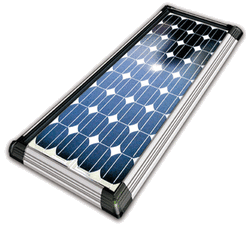If we’re trying to judge solar panel efficiency we should probably know what “efficiency” means?
Solar module efficiency refers to the ratio of output power to input power.
In other words: How much electricity can a solar panel produce from a certain amount of sunlight.
So if a solar panel creates a hundred watts of power from a thousand watts of sunlight, it has a solar power efficiency of 10%.
Solar panel efficiency can also be a tricky issue, however.
Different companies claim to have the most efficient panel and they’re not lying, they are just making their judgments on different criteria.
The two main category separations for “most efficient” are:
- Lab results vs. commercially available product
- Flat-panel vs. crystalline silicon panel
We can say generally that solar panel efficiency ranges from about 6% to over 20%. That’s quite a range isn’t it? But there is a good reason for it and it involves the flat-panel vs. crystalline silicon panel issue.
In the 6% efficiency range we have the products of companies like Uni-Solar and Kaneka. As you may have guessed, these companies produce thin-film solar products and not the traditional solar panels we’re used to.
Why would anyone buy these less efficient panels? Well, the main reason is that they’re cheaper. So if you look at it from the “how much electricity do I get for my money” point of view, thin-film technology is competitive with traditional solar panels.

Also, thin-film technology is actually more efficient than traditional solar panels in cloudy conditions and on hot days. Depending on your climate, this could be a big plus.
The average solar power efficiency for crystalline silicon (“traditional”) solar panels is in the 11%-13% range. So how have some panels achieved 20% efficiency? They’ve combined thin-film technology with crystalline silicon technology.
Sanyo is the leader in this “bifacial” module market. Sanyo’s “HIT Double” line uses crystalline silicon for the majority of the module’s power output. Thin-film technology is then used on the back of the panel to capture ambient light reflected off surrounding surfaces.
This bifacial idea may be a perfect solution if you have limited space and are looking to maximize power output.
Also, SunPower has just announced that they have developed a 333 Watt solar panel with a 20.4% total area efficiency. Unfortunately it will still be a while before it’s available commercially.
The important thing to remember is that unless you have a pressing reason to be concerned about the efficiency of solar panels (e.g. limited space), you should be more concerned with how many watts of power you’re getting for your dollar.
Combining solar module efficiency with cost will really let you know what you’re getting for your money.
The key is to get to know the specifics of your solar situation so you can decide what installation factors are most important to you.
